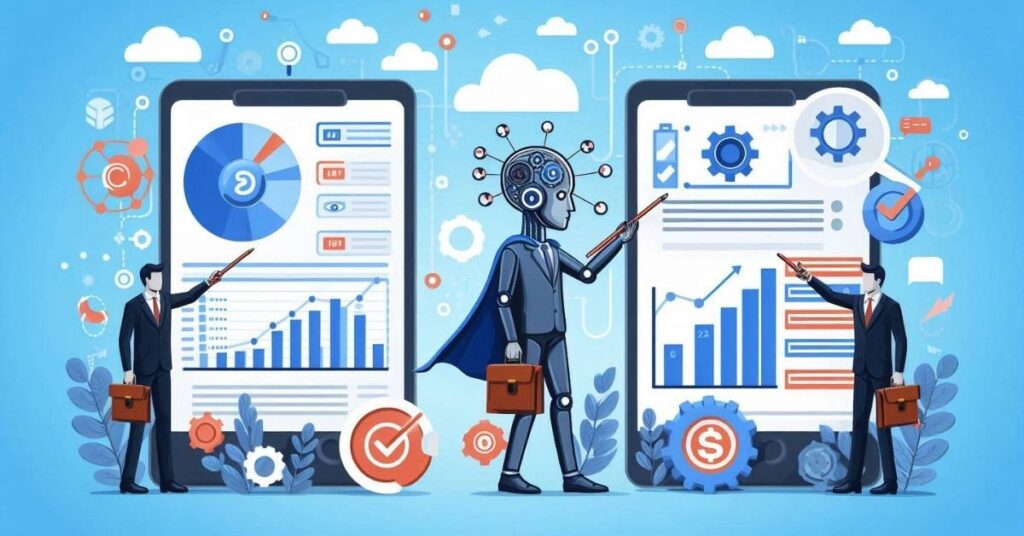
Imagine two sales teams:
- Team A spends hours manually scoring leads based on job titles and form fills—only to discover half their “hot” leads ghost them.
- Team B uses AI to analyze real-time website behavior, email engagement, and even call sentiment, automatically ranking leads by actual purchase intent.
Which team closes more deals?
The answer is reshaping sales pipelines everywhere. AI-driven lead scoring is replacing (or supercharging) traditional methods—and the results are staggering. In this breakdown, we’ll compare both approaches, reveal their strengths/weaknesses, and show how SaleSix.AI’s Agentic AI helps teams leverage the best of both worlds.
Traditional Lead Scoring: The Old-School Playbook
How It Works
Sales and marketing teams assign fixed point values to lead attributes:
| Criteria | Points | Flaws |
|---|---|---|
| Job Title = “Director+” | +20 | Ignores if they’re just browsing |
| Downloaded Pricing Sheet | +30 | Doesn’t track if they read it |
| Company Size >500 Employees | +15 | Revenue ≠ urgency |
Common Tools:
- HubSpot, Marketo, or Salesforce manual scoring rules
- Spreadsheet-based grading (yes, some still do this)
Pros
✔ Simple to set up (if you know your ideal customer profile)
✔ Transparent logic (easy to explain to stakeholders)
Cons
❌ Static & rigid – Fails to adapt to new trends (e.g., a surge in healthcare leads post-policy change).
❌ Ignores intent signals – A “VP” who spends 2 minutes on your site scores higher than a “Manager” who reads 10 pages.
❌ Delayed updates – Lead scores decay unless manually refreshed.
Real-World Impact: A SaaS company found 42% of their “A-tier” leads were unresponsive—all scored traditionally.
AI-Driven Lead Scoring: The Smarter, Faster Alternative
How It Works
AI models analyze 100+ behavioral and firmographic signals in real-time:
| Data Type | AI Analysis | Why It’s Better |
|---|---|---|
| Website Behavior | Pages visited, time spent, repeat visits | Detects buying intent (e.g., pricing page + case studies = hot lead) |
| Email Engagement | Opens, clicks, reply timing | Scores urgency (e.g., opened 3 emails in 1 day) |
| Call Sentiment | Keyword detection (e.g., “budget approved”) | Captures verbal buying signals |
Tools:
- Predictive scoring (6sense, ZoomInfo)
- Conversational AI (SaleSix.AI, Gong)
Pros
✔ Dynamic & adaptive – Self-learns from won/lost deals (e.g., notices “mid-market retail” leads convert 3X faster).
✔ Real-time prioritization – Flags hot leads while they’re still engaged.
✔ Reduces human bias – Scores based on actions, not just titles.
Cons
❌ Requires clean data – Garbage in, garbage out.
❌ Black box stigma – Some reps distrust AI’s logic (solution: explainable AI dashboards).
Case Study: A fintech firm using AI scoring saw 35% more demos booked by focusing on leads who:
- Visited pricing + integrations pages
- Had 2+ team members engage
Head-to-Head Comparison
| Factor | Traditional Scoring | AI-Driven Scoring |
|---|---|---|
| Speed | Slow (manual updates) | Real-time |
| Accuracy | Low (40–60% precision) | High (75–90%+) |
| Scalability | Limited to rules | Handles 100K+ leads |
| Adaptability | Rigid | Learns continuously |
| Best For | Simple sales cycles | Complex/long cycles |
Key Takeaway: AI excels in B2B, enterprise sales, and high-volume pipelines where intent changes fast.
Hybrid Approach: When to Combine Both
- Use Traditional for Basics
- Firmographics (industry, revenue)
- Explicit data (form submissions)
- Layer AI for Behavior
- Dark funnel activity (anonymous visitors)
- Email/call sentiment
Example Workflow:
- Lead submits contact form → +20 points (traditional).
- AI detects 4 pricing page visits → +50 points.
- Total score = 70 (Sales alerted).
How to Get Started with AI Lead Scoring
- Audit Your Data
- Clean CRM duplicates.
- Track missing fields (e.g., technographics).
- Start Small
- Pilot AI on top-of-funnel leads first.
- Train Your Team
- Explain AI logic (e.g., “Leads watching demo videos convert 2X faster”).
Tool Recommendation: Platforms like SaleSix.AI integrate AI scoring with automated outreach, so reps only call leads with >80% conversion likelihood.
The Future Is Predictive
Traditional lead scoring is like using a paper map—functional, but outdated in a GPS world. AI-driven scoring adapts, learns, and prioritizes what actually matters—slashing wasted outreach and boosting win rates.




